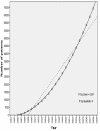The National Tumor Association Foundation (ANT): A 30 year old model of home palliative care
- PMID: 20529310
- PMCID: PMC2900232
- DOI: 10.1186/1472-684X-9-12
The National Tumor Association Foundation (ANT): A 30 year old model of home palliative care
Abstract
Background: Models of palliative care delivery develop within a social, cultural, and political context. This paper describes the 30-year history of the National Tumor Association (ANT), a palliative care organization founded in the Italian province of Bologna, focusing on this model of home care for palliative cancer patients and on its evaluation.
Methods: Data were collected from the 1986-2008 ANT archives and documents from the Emilia-Romagna Region Health Department, Italy. Outcomes of interest were changed in: number of patients served, performance status at admission (Karnofsky Performance Status score [KPS]), length of participation in the program (days of care provided), place of death (home vs. hospital/hospice), and satisfaction with care. Statistical methods included linear and quadratic regressions. A linear and a quadratic regressions were generated; the independent variable was the year, while the dependent one was the number of patients from 1986 to 2008. Two linear regressions were generated for patients died at home and in the hospital, respectively. For each regression, the R square, the unstandardized and standardized coefficients and related P-values were estimated.
Results: The number of patients served by ANT has increased continuously from 131 (1986) to a cumulative total of 69,336 patients (2008), at a steady rate of approximately 121 additional patients per year and with no significant gender difference. The annual number of home visits increased from 6,357 (1985) to 904,782 (2008). More ANT patients died at home than in hospice or hospital; this proportion increased from 60% (1987) to 80% (2007). The rate of growth in the number of patients dying in hospital/hospice was approximately 40 patients/year (p < 0.01), vs. approximately 177 patients/year for patients who died at home. The percentage of patients with KPS < 40 at admission decreased from 70% (2003) to 30% (2008); the percentage of patients with KPS > 40 increased. Mean days of care for patients with KPS > 40 exceeded mean days for patients with KPS < 40 (p < 0.001). Patients and caregivers reported high satisfaction with care in each year of assessment; in 2008, among 187 interviewed caregivers, 95% judged the quality of doctors' assistance, and 91% judged the quality of nurses' assistance, to be "optimal."
Conclusions: The ANT home care model of palliative care delivery has been well-received, with progressively growing numbers of patients served. It has resulted in a greater proportion of home deaths and in patients' accessing palliative care at an earlier point in the disease trajectory. Changes in ANT chronicle palliative care trends in general.
Figures








Similar articles
-
[Accessibility of home palliative care and place of death of cancer patients: data analysis of the Emilia-Romagna Region.].Recenti Prog Med. 2018 Mar;109(3):185-192. doi: 10.1701/2876.29003. Recenti Prog Med. 2018. PMID: 29565052 Italian.
-
Using Admission Karnofsky Performance Status as a Guide for Palliative Care Discharge Needs.J Palliat Med. 2021 Jun;24(6):910-913. doi: 10.1089/jpm.2020.0543. Epub 2021 Feb 1. J Palliat Med. 2021. PMID: 33524302 Free PMC article.
-
The ANT Home Care Model in Palliative and End-of-Life Care. An Investigation on Family Caregivers' Satisfaction with the Services Provided.Transl Med UniSa. 2020 Oct 1;23:1-6. doi: 10.37825/2239-9747.1022. eCollection 2020 Sep. Transl Med UniSa. 2020. PMID: 34447700 Free PMC article.
-
Home palliative care and end of life issues in glioblastoma multiforme: results and comments from a homogeneous cohort of patients.Neurosurg Focus. 2014 Dec;37(6):E5. doi: 10.3171/2014.9.FOCUS14493. Neurosurg Focus. 2014. PMID: 25434390
-
Prognostic factors of survival in patients with advanced cancer admitted to home care.J Pain Symptom Manage. 2013 Jan;45(1):56-62. doi: 10.1016/j.jpainsymman.2011.12.288. Epub 2012 Sep 24. J Pain Symptom Manage. 2013. PMID: 23017625
Cited by
-
Creating a Culture of Health in Planning and Implementing Innovative Strategies Addressing Non-communicable Chronic Diseases.Front Sociol. 2019 Feb 26;4:9. doi: 10.3389/fsoc.2019.00009. eCollection 2019. Front Sociol. 2019. PMID: 33869336 Free PMC article. Review.
-
Identifying the prevalence of unmet supportive care needs among family caregivers of cancer patients: an Italian investigation on home palliative care setting.Support Care Cancer. 2022 Apr;30(4):3451-3461. doi: 10.1007/s00520-021-06655-2. Epub 2022 Jan 9. Support Care Cancer. 2022. PMID: 34999950
-
Associations between caregiving worries and psychophysical well-being. An investigation on home-cared cancer patients family caregivers.Support Care Cancer. 2016 Feb;24(2):857-863. doi: 10.1007/s00520-015-2854-y. Epub 2015 Jul 24. Support Care Cancer. 2016. PMID: 26201751
-
Home Artificial Nutrition and Energy Balance in Cancer Patients: Nutritional and Clinical Outcomes.Nutrients. 2022 Oct 14;14(20):4307. doi: 10.3390/nu14204307. Nutrients. 2022. PMID: 36296990 Free PMC article.
-
Can Naloxegol Therapy Improve Quality of Life in Patients with Advanced Cancer?Cancers (Basel). 2021 Nov 16;13(22):5736. doi: 10.3390/cancers13225736. Cancers (Basel). 2021. PMID: 34830889 Free PMC article.
References
-
- Rinck GC, van den Bos GA, Kleijnen J, de Haes HJ, Schade E, Veenhof CH. Methodologic issues in effectiveness research on palliative cancer care. J Clin Oncol. 1989;15:1697–1707. - PubMed
LinkOut - more resources
Full Text Sources

